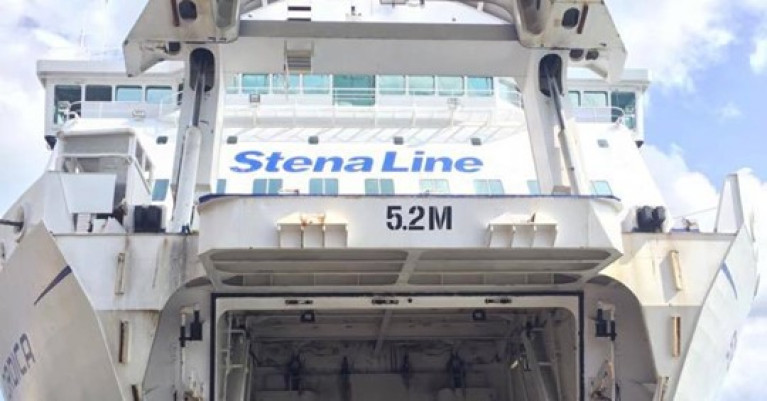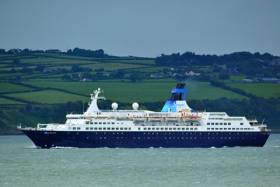Displaying items by tag: south Wales ports
Calls to Close Either Port of Pembroke Or Fishguard 'A Catastrophe'
A Welsh Affairs Committee last Thursday heard that it would make logistic and economic sense for Pembrokeshire to operate one ferry port, possibly being served by two companies, with back-to-back sailings to Rosslare.
"A lot of the ferry company customers would like to see a one port solution where you get two ferry operators but operating a back-to-back timetable," he said. "That would be the utopia because you'd have a six-hour frequency," Stena Line's head of UK port authorities, Ian Davies, told the committee.
"Logic yes would say it would make more sense from a logistics point of view and an economic point of view to have one strong ferry port with frequency of service. Obviously at Fishguard Port we would say that should be Fishguard because it's the shorter ferry crossing."
In the same week Glenn Carr, general manager at Rosslare Europort in Ireland, said that having a consolidated ferry service to and from one Pembrokeshire port could encourage hauliers back into using the ports and the land bridge.
For much more, The Western Telegraph has the story.
In addition BBC News reported that Stena Line said it remains 'committed to Wales' with its ports and ferry routes and despite a drop in traffic due to Brexit and Covid-19.
South Wales Ports Promoted As Cruise Destinations
#CruiseLiners - The 2018 season was successful at the ports of Swansea and Cardiff, according to port owner and operator ABP which is to further develop the cruise sector in the south Wales region throughout 2019 and beyond.
Representatives from ABP South Wales will be attending the annual SeaTrade Cruise Med event in Lisbon, Portugal starting today and tomorrow (20th September) to further promote the region's ports to the industry.
The Port of Cardiff already has several bookings for cruise vessel calls the 2019 and 2020 seasons, where passengers will either visit Wales as part of their cruise itineraries, or embark on their cruise voyages from the port.
Between May and September 2018, six cruise calls and over 4,000 passengers relied on the port facilities in Cardiff and Swansea provided by ABP South Wales.
As well as continuing to support day calls, ABP South Wales believes there is significant potential to increase the number of cruise holidays that embark in South Wales to provide greater accessibility and ease for passengers from Wales, the South West, and the Midlands.
South Wales ABP Ports See Strong Growth in 2017
#Ports&Shipping - Five ports in south Wales that are part of Associated British Ports (ABP) a major UK ports operator, saw the group's regional network handle 12.5 million tonnes of cargo in 2017.
The strong performance of ABP South Wales was due to major investment in infrastructure and ongoing commitment to delivering the highest standards of customer service.
12.5 million tonnes of cargo were handled at Newport, Cardiff, Barry, Port Talbot and Swansea with strong growth in both traditional and emerging sectors, serving south Wales and the wider UK economy.
Year-on-year growth was seen in several commodities. Fertiliser to support agriculture and aggregates for manufacturing were 14% up on 2016, whilst animal feed leapt by some 54%. Recyclables increased by 72% and scrap metal, both exports and imports, doubled in volume compared to the previous year, registering a rise of 108%.
ABP South Wales Director, Matthew Kennerley, said: “Our five ports are continuing to see strong growth hanks to the investment we have been delivering in enhanced infrastructure and facilities. This has helped both new and longstanding customers to further develop and grow their businesses.
“Our ports in south Wales are vital strategic assets of national importance. Strong growth across our ports is not just success for ABP and our customers, it’s success for the Welsh economy.
“Every year our ports contribute £1.4m to the economy and support 15,000 jobs. We are committed to continuing to invest to support our customers, enabling that contribution to grow. We’re excited about the growth that our investment promises to deliver in the year ahead.”
ABP South Wales welcomed several new businesses to their ports throughout 2017. Notably, in September 2017, Swansea Dry Docks Ltd (SDL) reopened the Swansea’s drydock facilities (as reported on Afloat) on a long term lease and welcomed its first vessel following an extensive upgrade of facilities. This long term commitment by SDL will provide a boost to the local economy in terms of skilled employment and increased demand for specialist materials and services.
The growth seen in the handling of project cargo in 2016 was built upon in 2017 as the port of Swansea continued to support the renewable energy sector by handling wind turbine components for local projects. The port handled all components for the Brechfa Forest Wind Farm project, a 28 turbine project based in Carmarthenshire.
Investments were also made into key pieces of infrastructure to ensure the future stability of ABP’s South Wales ports and the surrounding area. In August 2017, the refurbishment of Green Park in Port Talbot was completed. This 18 month major renovation project represents an investment of £2.7 million by ABP South Wales. It will provide huge benefits to the River Afan in terms of improved water management and increased water security for TATA’s Port Talbot steel works.






























































